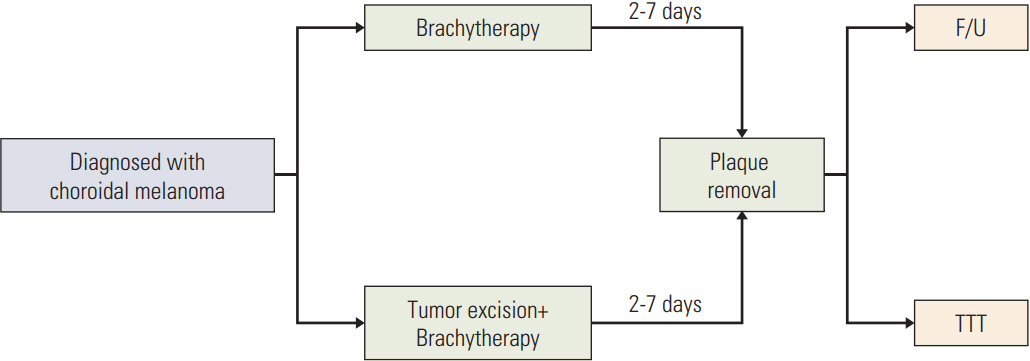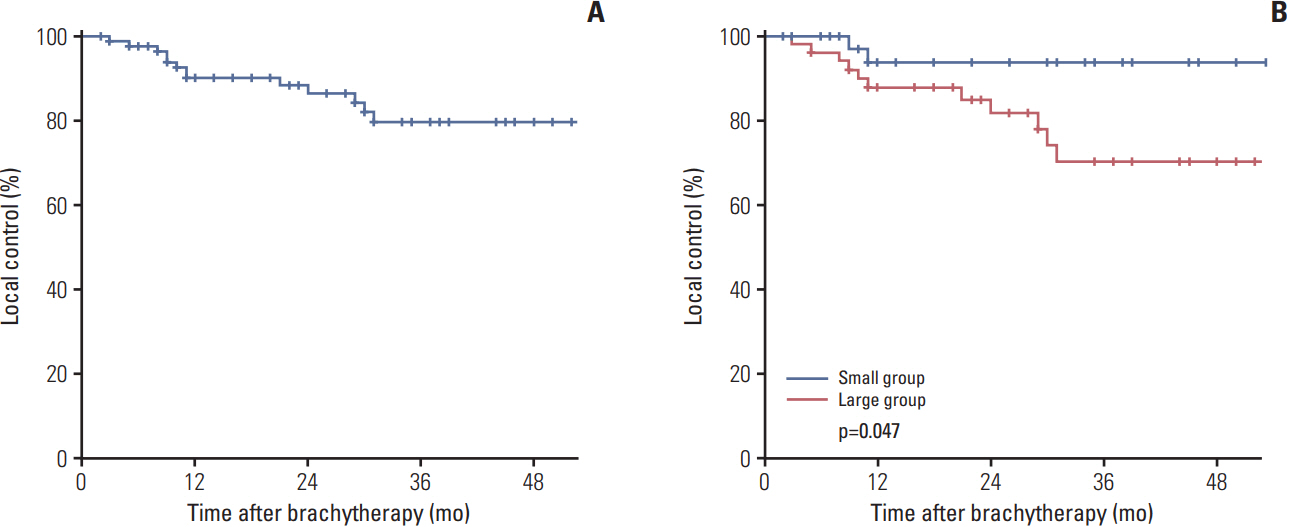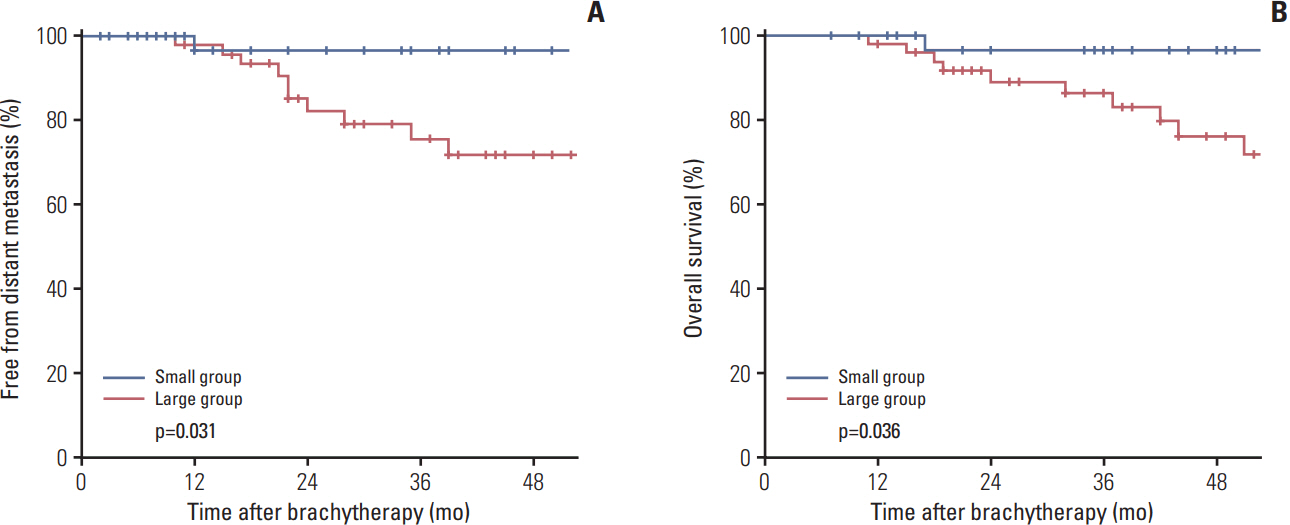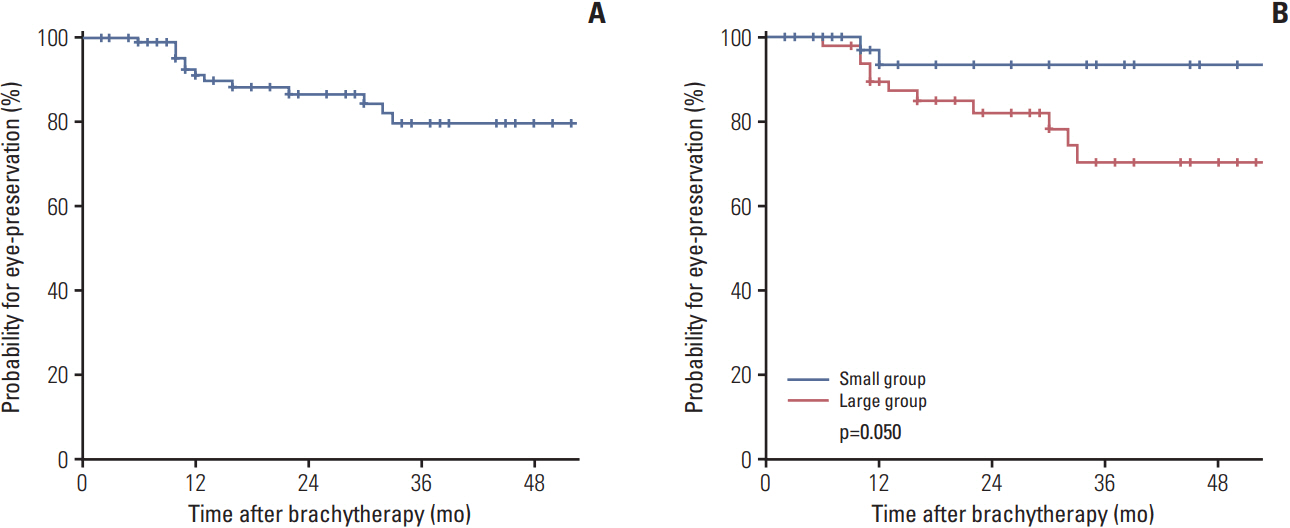Cancer Res Treat.
2018 Jan;50(1):138-147. 10.4143/crt.2016.391.
Ruthenium-106 Brachytherapy with or without Additional Local Therapy Shows Favorable Outcome for Variable-Sized Choroidal Melanomas in Korean Patients
- Affiliations
-
- 1Department of Radiation Oncology, Yonsei Cancer Center, Yonsei University College of Medicine, Seoul, Korea. kckeum@yuhs.ac
- 2Department of Ophthalmology, Institute of Vision Research, Severance Hospital, Yonsei University College of Medicine, Seoul, Korea.
- KMID: 2403483
- DOI: http://doi.org/10.4143/crt.2016.391
Abstract
- PURPOSE
The purpose of this study was to report clinical outcomes of ruthenium-106 (106Ru) brachytherapy with or without additional local therapy for choroidal melanomas in Korean patients.
MATERIALS AND METHODS
A total of 88 patients diagnosed with choroidal melanomas were treated with 106Ru brachytherapy between 2006 and 2012. Patients were divided into two groups according to their tumor height: a large group (≥ 6 mm, n=50) and a small group (< 6 mm, n=38). Most patients in the large group received combined therapy with local excision and/or transpupillary thermotherapy. In general, 85-95 Gy was administered to the apex of the tumor, while 100 Gy was administered to the point 2-6 mm from the outer surface of the sclera for patients undergoing combined therapy.
RESULTS
The median follow-up duration was 30 months. The 3-year local control rate was significantly higher in the small group than in the large group (94% vs. 70%, p=0.047). The free from distant metastasis (FFDM) rate and the overall survival (OS) rate were also higher in patients in the small group (3-year FFDM, 97% vs. 76%; p=0.031 and 3-year OS, 97% vs. 72%; p=0.036). A total of 13 patients underwent enucleation. The eye-preservation rate was also higher in the small group (3-year eye-preservation rate, 94% vs. 70%; p=0.050), and tumor height was a significant prognostic factor for eye-preservation.
CONCLUSION
106Ru brachytherapy showed favorable outcomes in small choroidal melanomas in Korean patients. Although additional local treatment could improve eye-preservation rate for large tumors, other strategies should be considered for disease control.
MeSH Terms
Figure
Cited by 1 articles
-
Prognostic Factors and Decision Tree for Long-Term Survival in Metastatic Uveal Melanoma
Daniel Lorenzo, María Ochoa, Josep Maria Piulats, Cristina Gutiérrez, Luis Arias, Jaume Català, María Grau, Judith Peñafiel, Estefanía Cobos, Pere Garcia-Bru, Marcos Javier Rubio, Noel Padrón-Pérez, Bruno Dias, Joan Pera, Josep Maria Caminal
Cancer Res Treat. 2018;50(4):1130-1139. doi: 10.4143/crt.2017.171.
Reference
-
References
1. Kwon HJ, Ko JS, Kim M, Lee CS, Lee SC. Prognosis of choroidal melanoma and the result of ruthenium brachytherapy combined with transpupillary thermotherapy in Korean patients. Br J Ophthalmol. 2013; 97:653–8.
Article2. Diener-West M, Earle JD, Fine SL, Hawkins BS, Moy CS, Reynolds SM, et al. The COMS randomized trial of iodine 125 brachytherapy for choroidal melanoma, III: initial mortality findings. COMS Report No. 18. Arch Ophthalmol. 2001; 119:969–82.3. Diener-West M, Earle JD, Fine SL, Hawkins BS, Moy CS, Reynolds SM, et al. The COMS randomized trial of iodine 125 brachytherapy for choroidal melanoma, II: characteristics of patients enrolled and not enrolled. COMS Report No. 17. Arch Ophthalmol. 2001; 119:951–65.4. Collaborative Ocular Melanoma Study Group. Ten-year follow-up of fellow eyes of patients enrolled in Collaborative Ocular Melanoma Study randomized trials: COMS report no. 22. Ophthalmology. 2004; 111:966–76.5. Lommatzsch PK, Werschnik C, Schuster E. Long-term follow-up of Ru-106/Rh-106 brachytherapy for posterior uveal melanoma. Graefes Arch Clin Exp Ophthalmol. 2000; 238:129–37.
Article6. Potter R, Janssen K, Prott FJ, Widder J, Haverkamp U, Busse H, et al. Ruthenium-106 eye plaque brachytherapy in the conservative treatment of uveal melanoma: evaluation of 175 patients treated with 150 Gy from 1981-1989. Front Radiat Ther Oncol. 1997; 30:143–9.7. Seregard S, aft Trampe E, Lax I, Kock E, Lundell G. Results following episcleral ruthenium plaque radiotherapy for posterior uveal melanoma. The Swedish experience. Acta Ophthalmol Scand. 1997; 75:11–6.
Article8. Shields CL, Bianciotto C, Rudich D, Materin MA, Ganguly A, Shields JA. Regression of uveal melanoma after plaque radiotherapy and thermotherapy based on chromosome 3 status. Retina. 2008; 28:1289–95.
Article9. Lommatzsch PK, Weise B, Ballin R. Optimization of irradiation time in the treatment of malignant melanoma of the choroid with beta applicators (106Ru/106Rh). Klin Monbl Augenheilkd. 1986; 189:133–40.10. Yarovoy AA, Magaramov DA, Bulgakova ES. The comparison of ruthenium brachytherapy and simultaneous transpupillary thermotherapy of choroidal melanoma with brachytherapy alone. Brachytherapy. 2012; 11:224–9.11. Shields CL, Cater J, Shields JA, Chao A, Krema H, Materin M, et al. Combined plaque radiotherapy and transpupillary thermotherapy for choroidal melanoma: tumor control and treatment complications in 270 consecutive patients. Arch Ophthalmol. 2002; 120:933–40.12. Lommatzsch PK. Results after beta-irradiation (106Ru/106Rh) of choroidal melanomas: 20 years’ experience. Br J Ophthalmol. 1986; 70:844–51.
Article13. Hawkins BS; Collaborative Ocular Melanoma Study Group. The Collaborative Ocular Melanoma Study (COMS) randomized trial of pre-enucleation radiation of large choroidal melanoma: IV. Ten-year mortality findings and prognostic factors. COMS report number 24. Am J Ophthalmol. 2004; 138:936–51.14. Krema H, Heydarian M, Beiki-Ardakani A, Weisbrod D, Xu W, Simpson ER, et al. A comparison between 125Iodine brachytherapy and stereotactic radiotherapy in the management of juxtapapillary choroidal melanoma. Br J Ophthalmol. 2013; 97:327–32.15. Kaiserman N, Kaiserman I, Hendler K, Frenkel S, Pe’er J. Ruthenium-106 plaque brachytherapy for thick posterior uveal melanomas. Br J Ophthalmol. 2009; 93:1167–71.
Article16. Mashayekhi A, Shields CL, Rishi P, Atalay HT, Pellegrini M, McLaughlin JP, et al. Primary transpupillary thermotherapy for choroidal melanoma in 391 cases: importance of risk factors in tumor control. Ophthalmology. 2015; 122:600–9.17. Seregard S, Landau I. Transpupillary thermotherapy as an adjunct to ruthenium plaque radiotherapy for choroidal melanoma. Acta Ophthalmol Scand. 2001; 79:19–22.
Article18. Kreusel KM, Bechrakis N, Riese J, Krause L, Wachtlin J, Foerster MH. Combined brachytherapy and transpupillary thermotherapy for large choroidal melanoma: tumor regression and early complications. Graefes Arch Clin Exp Ophthalmol. 2006; 244:1575–80.
Article19. Augsburger JJ, Schneider S, Narayana A, Breneman JC, Aron BS, Barrett WL, et al. Plaque radiotherapy for choroidal and ciliochoroidal melanomas with limited nodular extrascleral extension. Can J Ophthalmol. 2004; 39:380–7.
Article20. Damato B, Patel I, Campbell IR, Mayles HM, Errington RD. Visual acuity after Ruthenium106 brachytherapy of choro-idal melanomas. Int J Radiat Oncol Biol Phys. 2005; 63:392–400.21. Verschueren KM, Creutzberg CL, Schalij-Delfos NE, Ketelaars M, Klijsen FL, Haeseker BI, et al. Long-term outcomes of eye-conserving treatment with Ruthenium106 brachytherapy for choroidal melanoma. Radiother Oncol. 2010; 95:332–8.22. Lommatzsch PK, Alberti W, Lommatzsch R, Rohrwacher F. Radiation effects on the optic nerve observed after brachytherapy of choroidal melanomas with 106Ru/106Rh plaques. Graefes Arch Clin Exp Ophthalmol. 1994; 232:482–7.
Article23. Sakamoto T, Sakamoto M, Yoshikawa H, Hata Y, Ishibashi T, Ohnishi Y, et al. Histologic findings and prognosis of uveal malignant melanoma in japanese patients. Am J Ophthalmol. 1996; 121:276–83.
Article24. Bensoussan E, Thariat J, Maschi C, Delas J, Schouver ED, Herault J, et al. Outcomes after proton beam therapy for large choroidal melanomas in 492 Patients. Am J Ophthalmol. 2016; 165:78–87.
Article25. Konstantinidis L, Roberts D, Errington RD, Kacperek A, Heimann H, Damato B. Transpalpebral proton beam radiotherapy of choroidal melanoma. Br J Ophthalmol. 2015; 99:232–5.
Article26. Hawkins BS. Collaborative ocular melanoma study randomized trial of I-125 brachytherapy. Clin Trials. 2011; 8:661–73.
Article27. Danielli R, Ridolfi R, Chiarion-Sileni V, Queirolo P, Testori A, Plummer R, et al. Ipilimumab in pretreated patients with metastatic uveal melanoma: safety and clinical efficacy. Cancer Immunol Immunother. 2012; 61:41–8.
Article
- Full Text Links
- Actions
-
Cited
- CITED
-
- Close
- Share
- Similar articles
-
- Surgical Treatment of a Large Choroidal Melanoma
- Uveal Melanoma: A Review of the Literature and Personal Experiences
- Histochemical Electron Microscopy of Conjunctival Surface in Dry Eye Syndrome
- High-Dose-Rate Brachytherapy for Uterine Cervical Cancer : The Results of Different Fractionation Regimen
- Long-term Natural Course of Idiopathic Choroidal Neovascularization





